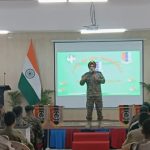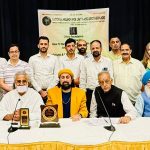The wonder that was Jammu can be an apt description to describe the region.A.L. Basham described India ‘s cultural legacy in his seminal work The Wonder That Was India keeping g in view the multitude of dimensions that shaped Indian heritage.In the similar vein at the regional level of the Indian statecraft, Jammu needs a complete and comprehensive work that will undertake a project documenting its evolution in space and time.Jammu region is blessed with architectural marvels throughout the length and breadth of the region. Excavations made at various places like Babor,26 miles east of Jammu city, Ambaran in Akhnoor are a few specimens of high civilization buried under the debris of time.Architecture of Jammu region can be divided into the following types- Cave Architecture, Structural Buildings. Temple Complexes, Temple Complexes, Secular Buildings, Palaces. Cave architecture has been found in Basohli on the banks of Ravi. These are rock cut caves. A whole section is devoted to Vishveshwara. It gives the description of the religious practices of the people of the region and their deities. Pir Khoh is another cave .It is situated below the circular road on the banks of Tawi. It was excavated in about 15th century A.D. The legend has it that it was the dwelling place of one of the warriors of the Ramayana period, Jambhvanta; who took shelter here to practice meditation. It is also known as Jambvant Gufha..It is a rock cut cave. Similar caves have been noticed in the periphery of Pur Mandal in Samba and are believed to be dating back to Pandavas. Pur Mandal holds a great significance in terms of religious importance. It is also known as Uttar Kashi in rest of India. It is equated with the Ganges in terms of religious significance. Structural buildings are the ones that include the monuments of refinement and symmetric geometry. The ruins that stand tall at various places like Babore and Krimchi reveal how the foundations of the buildings defined their structures..These buildings have a plan that has a triple star on a rectangular basement. The roof is supported on two rows of 24 large monolithic pillars, standing on well mounted bases.This pattern defines the structure of the buildings that have gigantic roofs and usage of stone is prominent with sculpture work depicting the religious and secular practices like daily chores and family traditions. Temple complexes of Jammu are magnificent and have diverse architectural styles .Krimchi reveals the architectural evolution of Dogra art. The temple of Sui Sumbli located in Jaffer Chak depicts many facets. It has architectural impressions that are of varying multitude. It has been built by using local wisdom and material but care has been taken to give it a pan Indian touch. It is not a mere temple but a dwelling place that has resources to cater to the needs of the whole village that houses this temple. Wall paintings depict the religious inclination and contemporary trends of the times and the priorities of the people . Jammu has witnessed secular tradition and as such it has given ample space to the people of other religions. Jammu city is known as the city of temples as it has numerous big and small temples that include Raghunath Temple, Ranvereshwar Temple, Panjbakhtar temple and other temples dedicated to local deities having family significance. But one cannot miss the appreciable number of Muslim shrines located in the city circles. Mosques that are prominent include the one at the C.P.O Chowk and the Talab Khatikan besides the Sufi shrines dedicated to Peer Babas .These shrines are held in high esteem even by Hindus of the region and are part of the shared heritage. These shrines have the uniqueness of art in terms of wall designs and domes and the tombs that reflect the outside influence. These Muslim Divines had arrived in Jammu from the central Asian regions for the purpose of proselytisation and spreading the message of Islam. Shrines of prominent divines that dot the cultural landscape of Jammu include that of Pir Mitha and Gaza Peer near the historical Gumat gate facing the ancient Hanuman temple. Secular tradition of Jammu emerged during the reign of Maharaja Ranjit Dev and was present even in the times of Mal Dev .
Search
Archives
- August 2025
- July 2025
- June 2025
- May 2025
- April 2025
- March 2025
- February 2025
- January 2025
- December 2024
- November 2024
- October 2024
- September 2024
- August 2024
- July 2024
- June 2024
- May 2024
- April 2024
- March 2024
- February 2024
- January 2024
- December 2023
- November 2023
- October 2023
- September 2023
- August 2023
- July 2023
- June 2023
- May 2023
- April 2023
- March 2023
- February 2023
- January 2023
- December 2022
- November 2022
- October 2022
- September 2022
- August 2022
- July 2022
- June 2022
- May 2022
© 2022 Foxiz News Network. Ruby Design Company. All Rights Reserved.










